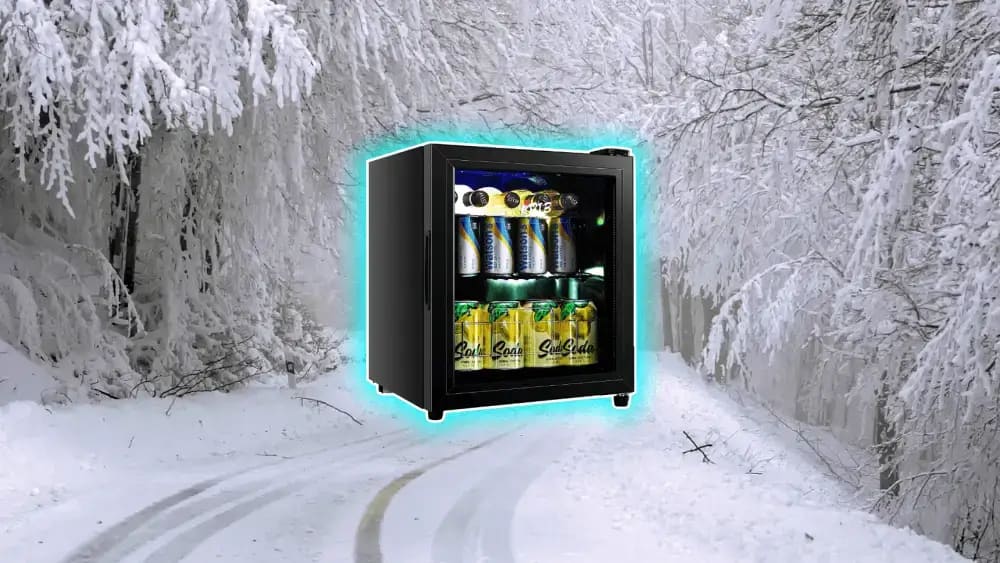Are you considering buying a mini fridge but wondering “How cold do mini fridges get?” These small but versatile appliances are commonly used in dorm rooms, offices, bedrooms, or even as a convenient addition to your kitchen. Mini fridges come in various sizes and designs, but one crucial factor to consider for many is their cooling capacity. No one wants a refrigerator that doesn’t keep food and beverages cold and fresh. That’s a fridge’s whole point: to keep our items fresh.
How cold do mini fridges get? The short answer is between 32°F (0°C) to 50°F (10°C) but it all depends on multiple factors that can influence the overall temperature of your mini fridge.
These temperatures are generally sufficient to preserve perishable items such as fruits, vegetables, dairy products, and beverages. However, it’s important to keep in mind that different models and brands may have slight variations in their cooling ranges, so it’s worth checking the specifications of the specific mini fridge you’re interested in to ensure it meets your needs.
Mini fridges, such as mini wine coolers, typically maintain a temperature range between 40°F (4°C) and 65°F (18°C). These fridges are designed to keep different types of wine cool and can also store other beverages. While it is acceptable to store milk and raw meat at temperatures of 40°F (4°C) and below, it is always best practice to use lower temperatures for longer preservation. Additionally, it’s important to be aware of the various factors that influence the overall inside temperature of a mini fridge.
What can influence the overall temperature of your mini fridge?
Understanding the factors that influence the overall temperature of your mini fridge is essential to optimize its performance. There are various aspects that actively affect the internal temperature of your mini fridge that can spoil your perishables. By recognizing these influential elements, you can take proactive steps to maintain an optimal environment inside your compact fridge.
- Thermostat Settings: You have the power to directly influence the overall temperature inside your mini fridge through the thermostat settings. By adjusting the settings, you actively take control of the cooling mechanism, enabling you to maintain the temperature you like.
- Door Openings: Every time you open the door of your mini fridge, warm air from the surroundings enters, causing a temporary rise in temperature. Frequently opening the door for prolonged periods actively disrupts the overall temperature inside the fridge.
- Ambient Temperature: The ambient temperature of the room or area where your mini fridge is placed can influence its internal temperature. Higher ambient temperatures can make the fridge work harder to cool down and maintain the set temperature. Thermoelectric mini fridges work best in environments with a stable ambient temperature range of 50°F (10°C) to 80°F (27°C), while compressor mini fridges can operate efficiently in a wider range of ambient temperatures, typically between 68°F (20°C) and 77°F (25°C).
- Placement: The location of your mini fridge within a room also affects its temperature. Placing it near heat sources like direct sunlight, ovens, or other appliances that generate heat can elevate the temperature inside the fridge.
- Overcrowding: The amount and arrangement of items inside your mini fridge can impact its temperature. Overcrowding restricts proper airflow, making it harder for the fridge to maintain an even temperature throughout.
- Maintenance and Cleanliness: Regular maintenance and cleanliness play a role in temperature as well. Dust, dirt, and debris can hinder the fridge’s cooling efficiency, affecting its ability to reach and maintain the desired temperature.
- Defrosting: Regularly defrosting your mini fridge is important to maintain optimal performance. Ice and frost buildup inside the fridge can hinder cooling efficiency and cause temperature fluctuations. By periodically defrosting your small refrigerator, you actively remove accumulated ice, allowing for better airflow and more efficient cooling.
In conclusion, the temperature range of mini fridges typically falls between 32°F (0°C) and 50°F (10°C). Factors that influence the overall temperature include thermostat settings, door openings, ambient temperature, placement, overcrowding, maintenance and cleanliness, and regular defrosting. By actively managing these factors, you can maintain the optimal temperature for preserving your food and beverages.

With over 15 years of experience in the appliance industry, I am a passionate advocate for efficient and stylish mini fridges. I specialize in energy-saving models and compact living solutions. As a certified appliance repair technician, I have a deep understanding of mini fridge maintenance and troubleshooting.

